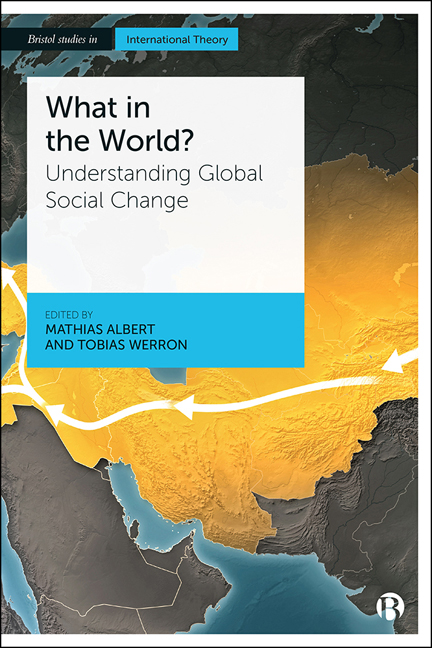Book contents
- Frontmatter
- Contents
- List of Figures and Tables
- Notes on Contributors
- Acknowledgements
- 1 Introduction: World Society and Its Histories – The Sociology and Global History of Global Social Change
- 2 Every Epoch, Time Frame or Date that Is Solid Melts into Air. Does It? The Entanglements of Global History and World Society
- 3 Periodization in Global History: The Productive Power of Comparing
- 4 Communication, Differentiation and the Evolution of World Society
- 5 Field Theory and Global Transformations in the Long Twentieth Century
- 6 Organization(s) of the World
- 7 Particularly Universal Encounters: Ethnographic Explorations into a Laboratory of World Society
- 8 From the First Sino-Roman War (That Never Happened) to Modern International-cum-Imperial Relations: Observing International Politics from an Evolution Theory Perspective
- 9 Nationalism as a Global Institution: A Historical-Sociological View
- 10 States and Markets: A Global Historical Sociology of Capitalist Governance
- 11 The Impact of Communications in Global History
- 12 The ‘Long Twentieth Century’ and the Making of World Trade Law
- 13 Third-Party Actors, Transparency and Global Military Affairs
- 14 Technical Internationalism and Global Social Change: A Critical Look at the Historiography of the United Nations
- References
- Index
4 - Communication, Differentiation and the Evolution of World Society
Published online by Cambridge University Press: 22 December 2021
- Frontmatter
- Contents
- List of Figures and Tables
- Notes on Contributors
- Acknowledgements
- 1 Introduction: World Society and Its Histories – The Sociology and Global History of Global Social Change
- 2 Every Epoch, Time Frame or Date that Is Solid Melts into Air. Does It? The Entanglements of Global History and World Society
- 3 Periodization in Global History: The Productive Power of Comparing
- 4 Communication, Differentiation and the Evolution of World Society
- 5 Field Theory and Global Transformations in the Long Twentieth Century
- 6 Organization(s) of the World
- 7 Particularly Universal Encounters: Ethnographic Explorations into a Laboratory of World Society
- 8 From the First Sino-Roman War (That Never Happened) to Modern International-cum-Imperial Relations: Observing International Politics from an Evolution Theory Perspective
- 9 Nationalism as a Global Institution: A Historical-Sociological View
- 10 States and Markets: A Global Historical Sociology of Capitalist Governance
- 11 The Impact of Communications in Global History
- 12 The ‘Long Twentieth Century’ and the Making of World Trade Law
- 13 Third-Party Actors, Transparency and Global Military Affairs
- 14 Technical Internationalism and Global Social Change: A Critical Look at the Historiography of the United Nations
- References
- Index
Summary
Introduction
We tend to think that the history of world society begins in the nineteenth century, but in fact, a pattern of ‘archaic globalization’ based on the exchange of commodities and on intercultural contacts had already emerged long before (Bayly, 2004, 2005). Interconnectedness as we usually think of it, however, scarcely existed up until the mid-nineteenth century: the many white spots on the maps and the fragmentary character of knowledge of the world inspired Hobsbawm (2004: 59) to state that ‘there was not, even in terms of geographical knowledge, one world’. The parameters of global connectedness changed dramatically during the nineteenth century, however, as railroad tracks and steamship routes allowed travelling within Europe and across the oceans with unprecedented speed and reliability, and the standardization of time made it possible to know not only where but also when a journey would end. Still, the development of a ‘world society’ was incremental and not without its hurdles: There were no airplanes and therefore long-distance journeys were time-consuming. Large parts of Africa, Asia and even America were still uncharted territory and difficult to reach at all. Telegraph cables connected the major European cities, the Americas and the colonial hubs in Asia, but the steep tariffs for sending messages limited the practical use of the telegraph to political and economic elites and prevented it from becoming a mass medium. The nation state and national collectives defined the new ‘international’ political stage, and diplomatic contacts and state visits flourished, yet large parts of the world were either under colonial rule or were governed by non-democratic regimes (if governed at all).
Despite those limitations, some features of contemporary world society were established or had at least begun to emerge by the end of the nineteenth century, most notably the interconnectedness through transport and communication networks, as well as the standardization and diffusion of political and other social institutions (Osterhammel, 2014). The global infrastructure for transport and communication improved by leaps and bounds: As early as 1872 it was possible to travel around the world in 80 days like Jules Verne's tourist pioneer Phileas Fogg, whereas in 1848, it would have taken a good 11 months. The rapid expansion of the transport infrastructure continued: 10,000 miles of railway lines in 1845 had already grown to 600,000 by 1920 (Lechner and Boli, 2005: 114–15).
- Type
- Chapter
- Information
- What in the World?Understanding Global Social Change, pp. 63 - 80Publisher: Bristol University PressPrint publication year: 2020

